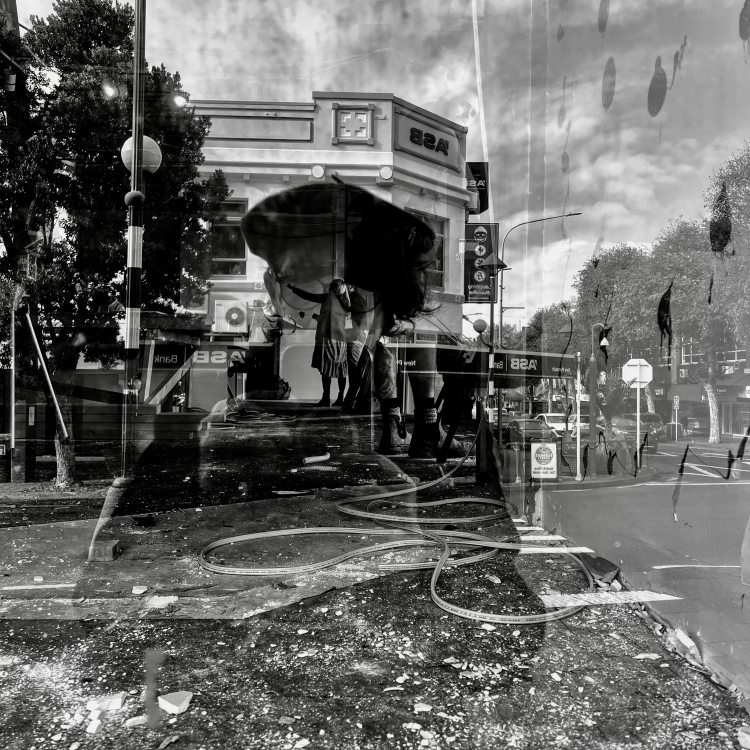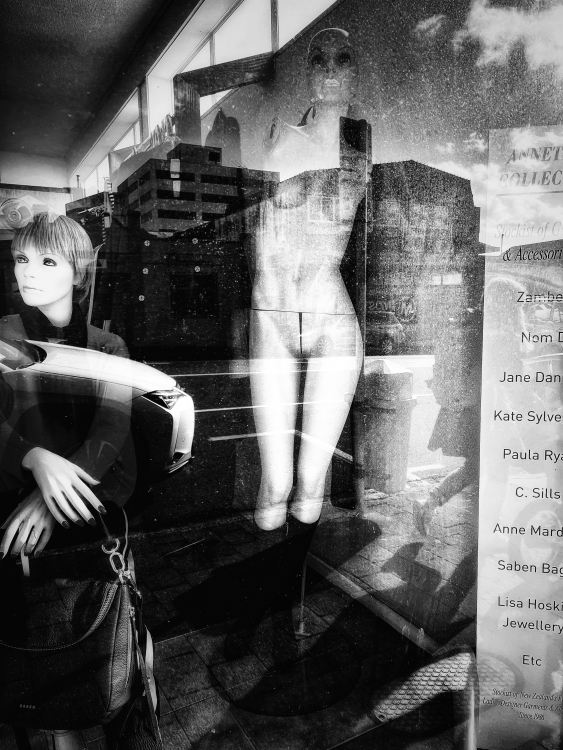The Watcher and the Reflection
Photographs by Rhonda Bunyan
STUART GREENHILL

RHONDA BUNYAN Morning. Coastal Taranaki 2022 Black-and-white photograph
Rhonda Bunyan is the retired director of Stratford’s Percy Thomson Gallery. She now spends her time in an old schoolhouse she has converted into her studio, at Ōkato.
Her photographic forte is large black-and-white photographs capturing everyday life in a way that is dramatically beautiful and challenging. Without colour, there are no distractions in her work, only form, and gradients of light and dark that play and spar with each other. Her subjects are an eclectic mix of no one specific genre, although she admits gritty cityscapes have the greatest appeal.
Texture, reflections, dissolved forms and mannequins are an important part of Bunyan’s art. In Self-Portrait. Storm reflection, she herself is a smudged silhouette behind a plastic blind. Droplets of rain texture the foreground, conveying a haunting sense of transience. She says, ‘I am in the picture but not the main subject. I am the watcher, sometimes I am the reflection. I believe we have a deeper essence than just our thoughts.’
That idea permeates through many of her images. In The Swimmer. Fitzroy. New Plymouth, strong contrasts highlight the pointillist texture of the swimmer’s back, as if the form is dissolving. Renovations and Reflections. New Plymouth and Posh Shop. New Plymouth take that idea further by blurring the line between abstraction and representation, making it difficult to discern whether the images are a studio montage or formed by the artist’s eye in the moment of seeing. Of course, it is the latter.
As the ‘watcher’, Bunyan finds anonymous unposed subjects for her portraits. Meet up. Hawera represents what she calls ‘a long day of days’, where the culmination of a person’s lifetime is conveyed by clothing, props, location, and gestures. Often cityscapes add to the narrative, offering flat planes and hard edges to generate a sense of isolation.
But Bunyan’s work does not require people to convey something powerful about the human condition. The richly textured sand in Footsteps. Opunake Beach recedes to a narrow slip of seascape, pushing the salient feature, the footprints, forward. The deeper meaning is secondary to the composition, but intrinsically Bunyan is aware of it. Is the walk of life a straight line, or is it a random tapestry of prints, aimless and free? Ironically, whatever the answer, the tide of time will dissolve them.
What is undeniable is Bunyan’s ability to intuitively select stunning images from the mundane that are loaded with meaning. What is permanent in Morning. Coastal Taranaki? Not the clouds, mist, stock, or fences but the land. The fundamental element of Bunyan’s art is to reveal a meaning behind the veneer, to prick our complacency, to challenge how we see, to invite us into being the watcher and to reflect.

RHONDA BUNYAN Self-Portrait. Storm reflection 2022 Black-and-white photograph

RHONDA BUNYAN Renovations and Reflections. New Plymouth 2022 Black-and-white photograph

RHONDA BUNYAN Posh shop. New Plymouth 2022 Black-and-white photograph

RHONDA BUNYAN Meet-up. Hawera 2022 Black-and-white photograph

RHONDA BUNYAN The Swimmer. Fitzroy. New Plymouth 2022 Black-and-white photograph

RHONDA BUNYAN Footsteps. Opunake Beach 2022 Black-and-white photograph
